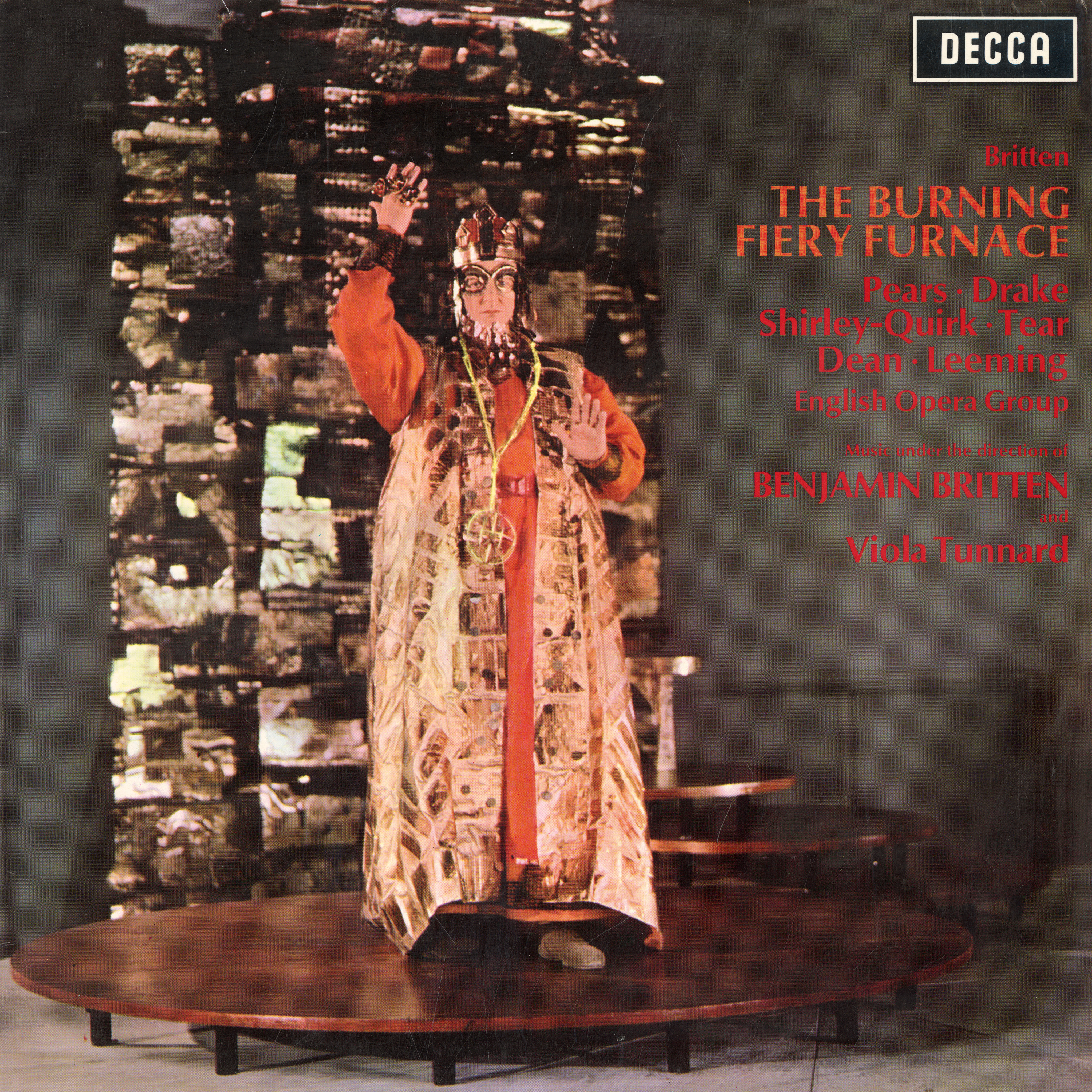It is a thoroughly singular experience.
If Britten's first church parable, Curlew River (BLOG), was a grim, personal experience, his second, The Burning Fiery Furnace, is a gaudy, community affair.
Britten follows a similar structure as the first - a bookended Medieval Abbey introduces the Biblical tale, featuring processional chanting from Monks and commentary from The Abbot.
To transition to the story proper, a heterophonic, Japanese instrumental interlude reminds listeners of Curlew River's inspiration from Noh theatre. Again, Britten uses a chamber ensemble, with individual instruments characterizing the scenes, seen in the top cover art, where Britten interacts with British harpist Osian Ellis. An alto trombone is added to the instrumentation of the First Parable, with pitched drums sounding out as an ever-present effect.
The Biblical parable follows the Babylonian King Nebuchadnezzar and his witnessing of the miracle where Shadrach, Meshach, and Abednego are saved from the titular Furnace. I use the term gaudy, only in the fact that the plot focuses more on establishing the palace of Nebuchadnezzar, his rich gala and accompanying retinue, rather than the drama surrounding the trio of Hebrew believers. There is even a whole scene (with odd speaking lines) dedicated to boy courtiers performing for the feasting company. Perhaps due to my familiarity with George Dyson's oratorio Nebuchadnezzar (BLOG), which fully explores this story's goings-ons, I didn't expect such a lopsided approach to the story.
Regardless, the listener is treated mainly to the singing of King Nebuchadnezzar from Peter Pears, as well as the King's Herald and Astrologer. Truthfully, the triad of visiting princes fromm Israel, who are cast into the Burning Fiery Furnace for not accepting Nebuchadnezzar's entreaties nor willing to worship the King's false Golden Idol, stay silent for much of the story. Too bad, for John Shirley-Quirk and Robert Tear could use more moments singing, although we do hear from the three here and there.
Otherwise, the English Opera Group chorus sings well and Decca's 60s recording is still in good sound. I assume, due to the popularity of Curlew River, a documentary was filmed about the making of this performance. Below, I have included the videos of the recording, the documentary by Tony Palmer, and the live BBC broadcast. A wealth of primary sources following the composer, his musicians, and the Decca recording team.
Like Wagner in his music dramas, Britten was involved in creating the costume and set designs as well as the music, seen in the cover art above. He even provides guidance regarding props and stage movements too, making these church parables closer to opera rather than an oratorio or cantata.
Because the story is not as gripping as Curlew River, The Burning Fiery Furnace is not quite as effective for this listener in comparison. However, Britten's music is, as ever, modern, yet approachable, giving the listener a musical and theatrical experience found nowhere else.
Works
The Burning Fiery Furnace
Soloists
Philip Langridge as Nebuchadnezzar
Bryan Drake as The Astrologer
Peter Leeming as The Herald
John Shirley-Quirk as Shadrach
Robert Tear as Meshach
Stafford Dean as Abednego
Richard Adeney, flute
Neill Sanders, horn
Roger Brenner, trombone
Cecil Aronowitz, viola
Keith Marjoram, double bass
Osian Ellis, harp
James Blades, percussion
Philip Ledger, organ
Performers
English Opera Group
Benjamin Britten, conductor
Label: Decca
Year: 1967; 1990
Total Timing: 63.36
Not as affecting as Curlew River, yet The Burning Fiery Furnace will be more approachable, at least as a story.
Too bad the libretto doesn't give as much time to the Biblical miracle in lieu of the secular spectacle of Nebuchadnezzar.
Still, Britten's music and presentation is unlike anything else, so this remains a treasure of sorts all the same.




No comments:
Post a Comment